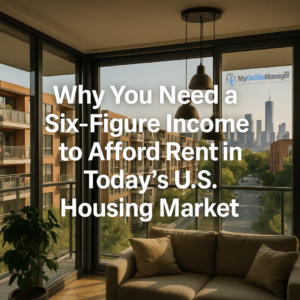The American rental market has reached a critical tipping point. Once considered the more affordable alternative to homeownership, renting is now straining household budgets nationwide. With home prices at historic highs and mortgage rates remaining stubbornly above 6%, millions of Americans are turning to renting. Unfortunately, this shift is placing unprecedented pressure on rental prices.
According to Zillow’s latest data, the average U.S. renter now needs to earn at least $80,000 per year just to comfortably cover the national median rent. That’s a steep jump from $60,000 in 2020, reflecting how fast housing costs have outpaced wage growth over the past five years (CBS News).
Rent in Major Cities Requires a Six-Figure Salary
Living in a major metropolitan area is becoming increasingly unattainable for middle-class households. Zillow reports that renters need over $100,000 per year to afford the typical apartment in eight major U.S. cities:
-
Boston
-
Los Angeles
-
Miami
-
New York City
-
San Diego
-
San Francisco
-
San Jose
-
Riverside, California
Among these, New York City leads the pack, with the average renter needing an annual salary of about $135,000—nearly double the national median income. The typical NYC apartment now costs around $2,950 per month, which is roughly 59% higher than the national average (CBS News).
Why Are Rents So High?
1. A Persistent Housing Shortage
Although developers are adding hundreds of thousands of new units each year, construction still lags behind the demand for affordable housing. Kara Ng, a senior economist at Zillow, explains that the mismatch between supply and demand continues to push rents upward, particularly in urban centers where land and building costs are high.
2. Wage Growth Is Falling Behind
Since April 2020, average rent has risen by nearly 30%, climbing to $1,858 per month. During the same period, U.S. household income has grown by only 22.5%, reaching about $82,000. This gap means that even renters with solid incomes are dedicating larger portions of their paychecks to housing, often leaving less room for savings or discretionary spending.
3. Economic Pressures on Renters
Rachel Fee, Executive Director of the New York Housing Conference, notes that rent hikes are “skyrocketing, and renters just can’t keep up.” With essentials like groceries, transportation, and healthcare also rising in cost, renters are being forced to make difficult financial trade-offs.
The 30% Rule No Longer Works
Financial experts often recommend spending no more than 30% of your income on housing, but in many cities, this is now unrealistic. For example, to rent a $3,000/month apartment in a city like Los Angeles or Miami while following the 30% rule, a household would need to earn at least $120,000/year. For single-income households, this threshold is nearly unattainable without taking on additional jobs or roommates.
The Suburban Shift and Rising Costs
Traditionally, moving to the suburbs was considered a way to save money, but Zillow’s research indicates that suburban rents are rising even faster than those in major urban centers. Many renters who fled cities during the pandemic are now competing for limited suburban inventory, further driving up prices.
Policy and Solutions Under Debate
Experts like Rachel Fee emphasize that government intervention is critical to stabilize the rental market. Proposals include:
-
Expanding the Low-Income Housing Tax Credit (LIHTC) to incentivize developers to build affordable units.
-
Providing rental subsidies or tax breaks for middle-income renters.
-
Accelerating zoning reforms to encourage multi-family housing construction.
While these measures could help, they face political hurdles, meaning relief for renters may not come anytime soon.
The Long-Term Impact on Homeownership
The surge in rent isn’t just affecting renters today—it’s also delaying homeownership for millions. With more of their paychecks going toward rent, people have less money to save for down payments. This creates a cycle where rising rents and high home prices work together to lock individuals out of the housing market entirely.
Key Statistics
| Metric | Value |
|---|---|
| National median rent | ~$1,858/month |
| Required income for affordable rent | $80,000/year |
| Cities requiring 6-figure incomes | 8 major metros |
| Income needed in NYC | $135,000/year |
| Rent increase since 2020 | +30% |
| Wage increase since 2020 | +22.5% |
Final Takeaway
The U.S. rental market is in uncharted territory. What was once an affordable option for middle-income families is now financially out of reach for many. With rents surging far faster than wages and supply still tight, the dream of financial stability through renting—or even transitioning to homeownership—is becoming harder to achieve.
Until significant changes are made in housing policy and development, many Americans will continue to find themselves trapped in a cycle of high rent, low savings, and limited options.
Source: CBS News – “8 U.S. cities where you need to earn at least $100,000 to live comfortably”

